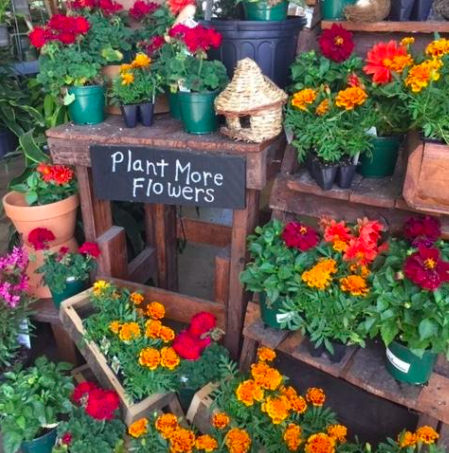
-Pam Scott-
There is no better way to bring continuous color into your garden throughout the spring, summer and fall than to plant blooming annuals. Annual flowers will usually bloom profusely for one entire growing season and then die off in the cold months, whereas perennial flowering plants will most often bloom for a short time, become dormant and then reappear the following year. Annual flowers add color to the garden when perennial plants stop blooming or become dormant. By planting annual flowers in and around your perennial beds you can be assured that there will always be something in bloom throughout the growing season.
I plant pots of colorful annual flowers every year and place them around my perennials and native shrubs. I have 2 very large dogs that will lay waste to the garden unless there is something in the way to direct the dog-romping traffic to specific areas. The perennial plants grow safely between the pots of annuals and it creates a full and flowering effect.
Pots, hanging baskets, window boxes and rail planters filled with blooming plants can bring either a riot of color or soft soothing tones to a deck, the front entrance to the house, windowsills, or any outdoor seating area where inground planting is not possible. Pots of shade-loving annuals can be used to brighten a dark area in the garden as well. You can have tons of fun designing these floral vignettes, and you will be rewarded with a full season of blooming beauty.
To start you will need to know what kind of light your potted annuals will be getting. You can choose from an array of sun-loving plants such as petunias, calibrachoa, lantanas, verbenas and nasturtiums, just to name a few. The varieties and color choices are endless. These sun-loving annuals will need at least 5 or 6 hours of sunlight to produce blooms throughout the summer and into fall. If you are needing to brighten a shady area you can use more shade-loving annuals such as coleus, browellia, impatiens, sweet potato vine, or begonias. Make sure you choose the right plants for the right space and conditions.
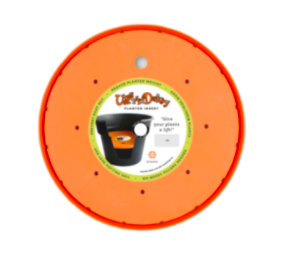
Choose your containers keeping size in mind. Make sure your plants will have room to grow and enough soil around them to hold moisture during the heat of the summer. When planting in pots or window boxes you can place your plants a bit closer than is recommended for inground planting. Make sure there is plenty of drainage in the bottom of the pot. When placing pots on ground soil, it is a good idea to lift them off the ground with bricks or pot feet so that the plant roots don’t grow through the drainage hole and into the ground, clogging up the hole and potentially drowning your plant. If using very tall pots, there is a product called the Ups-A-Daisy Planter Insert that is very useful (and money-saving!). There is one for almost any size pot and it is used to lift the soil up from the bottom of the pot, eliminating the need to fill a very large pot with a huge amount of soil. We stock these at most of our stores in an array of sizes.
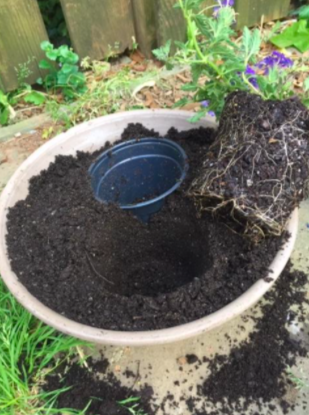
When choosing a potting mix for your potted annuals make sure to use a high quality, well-draining soil. I like using the Happy Frog potting soil mixed with ⅓ of the Mcenroe or Coast Of Maine Lobster compost. Mixing the soil with compost will allow for better water retention in the extreme summer heat. Fill your pot firmly with moist potting soil up to the height of the bottom of your annual plant root ball. I use an empty pot as a template and fill moist soil in around the empty pot, firm the soil around the pot then remove it and place the well-watered unpotted annual into the hole, gently firming the soil around it. If the root ball of your annual seedling is very compacted with dense roots you may want to loosen some of the roots before planting. Fill the soil around your plant up to the soil line of the plant. If the soil in the pot starts to recede as it settles, you can always top dress the plant with more soil. When planting be sure to leave an inch of space between the rim of the pot and the soil line so water will stay in the pot and not run off when watering.
When designing your blooming potted gardens keep in mind color, shape and texture. You may want to have tall plants in the center or back, a level of medium-height plants to fill in the middle, and something low and trailing around the base of the planting. Different shaped leaves will add interest to your composition; mixing bold, smooth leaves with more intricate leaves will add textural interest. Color combinations are also a big consideration when choosing plants. You may want to create a multicolor palette of tropical sunset colors (reds, yellows and oranges), or a primary color palette of reds yellows and blues. Softer shades of blues, silvers and whites create a cooling palette, the blues becoming luminous at dusk. Pots of white flowers, when placed against a dark backdrop will glow at night. If you are home to enjoy your garden only in the evenings, you may want to keep this in mind. Another design element to consider is that groupings of all one color or shade will have a more formal calming effect. A palette of multi colors will have a more casual, exciting effect.
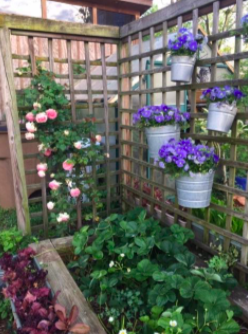
It is fun to think of interesting containers to plant in. One of my favorites is a galvanized bucket with holes drilled in the bottom. These can be hung from fences or trellises. When my children were little they would paint and plant their own floral potted gardens, using latex paint on terracotta pots. There are so many colors, shapes and sizes of pots to choose from in terra cotta, frost resistant glazes, lightweight plastics and coir filled hanging baskets, you will want to fill your yard with beautiful colorful containers of flowers.
Fertilize your annual pots with a slow-release liquid fertilizer such as BioThrive Bloom every 2-3 weeks or top dress with Happy Frog Fruit and Flower granular fertilizer every 3-4 weeks throughout the growing season. Make sure to check your plants for water every morning, and water before the sun hits them. Make sure to water thoroughly, keeping in mind that a full day of sun without water will surely damage, if not kill plants by evening.
When caring for your potted annual gardens be sure to deadhead the plants regularly. Pinching off the spent flowers and seed pods will keep them blooming and healthy. Petunias tend to get long and leggy in midsummer so giving them a haircut will keep them more compact and continually flowering. When watering, try to fill the pots from under the flowers and stems. Water on the petals can damage the flowers, and wet stems can lead to fungus.
With consistent watering, fertilizing, and deadheading, you can keep your beautiful annual potted gardens blooming all summer and into fall. Fifth Season Gardening has a wonderful array of garden plants, pots, tools, soils and amendments for all of your gardening projects, and we are here to answer your questions and give expert advice!
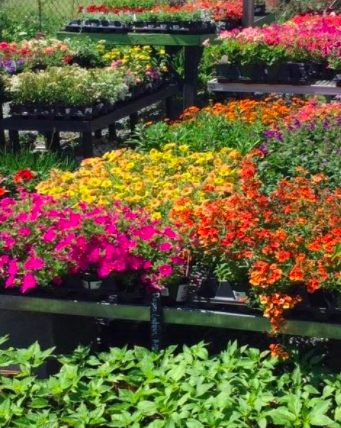

Home & Garden says
Great article. Thanks for sharing these amazing home gardening tips. I just love the tips that you have shared these are truly good ideas for home gardening.
Delma Taylor says
This was SO useful! Simply beginning my metropolitan nursery with a little deck and minuscule yard space and all that I can do to set aside cash will help. Exceptionally thankful for the thoughts. Will utilize a significant number of them while I set up my space. Likewise, I’ll utilize your member connect for the sacks. Can’t thank you enough!